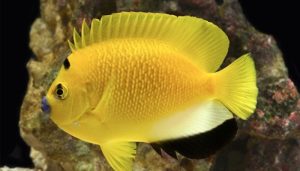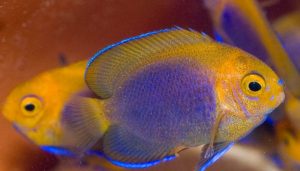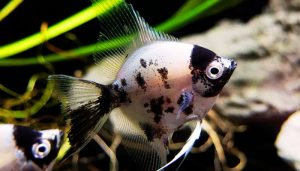Few fish captivate aquarists quite like the Halfmoon Betta Fish. Renowned for their vibrant colors and uniquely stunning tail that forms a perfect 180-degree arc, these fish have become a favorite among hobbyists and beginners alike.
But owning a Halfmoon Betta is about more than just its striking beauty—it’s a commitment to providing the right care and environment to let its elegance truly shine.
In this guide, we’ll dive deep into the fascinating world of Halfmoon Bettas, exploring the different types, their unique traits, and the essential care tips to keep them healthy and happy.
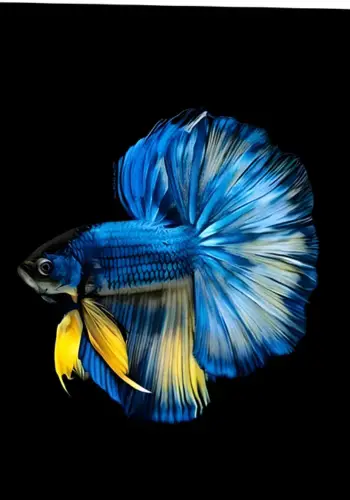
Whether you’re considering adding one to your aquarium or already have one of these aquatic gems, this article is your go-to resource for everything you need to know.
Ready to unlock the secrets to nurturing this majestic fish? Let’s get started!
Table of Contents
ToggleWhat Size Tank Does a Halfmoon Betta Need?
A Halfmoon Betta requires a tank that is at least 5 gallons (19 liters) to ensure it has enough space to swim and thrive. Here’s why this size is important:
- Adequate Swimming Space: Halfmoon Bettas have large, delicate fins that require plenty of room to move without damaging them.
- Water Stability: A 5-gallon tank provides more stable water parameters compared to smaller tanks, reducing stress and the risk of diseases.
- Filtration and Heating: The tank size accommodates a small filter and heater, both of which are essential for maintaining clean and warm water (76-82°F or 24-28°C), ideal for Bettas.
- Decoration and Enrichment: The extra space allows for plants, hiding spots, and other decorations that create a stimulating and safe environment.
While some sources might suggest smaller tanks, a larger tank promotes better physical and mental health for your Halfmoon Betta, making it easier to maintain long-term.
How Big Do Halfmoon Bettas Get?
Halfmoon Bettas typically grow to be about 2.5 to 3 inches (6.3 to 7.6 cm) in length from the tip of their nose to the end of their tail. Their body size is complemented by their stunning, large, fan-shaped fins, which can make them appear even larger when fully flared.
To ensure your Halfmoon Betta reaches its full size, provide:
- Proper Nutrition: A balanced diet with high-quality betta pellets, occasional live or frozen foods (like brine shrimp or bloodworms).
- Adequate Space: A tank size of at least 5 gallons with stable water conditions and a heater to maintain a temperature of 76–82°F (24–28°C).
- Stress-Free Environment: Keep the water clean, avoid aggressive tank mates, and provide plants or hiding spots.
With optimal care, these beautiful fish can reach their full potential and thrive in your aquarium!
Where Do Halfmoon Betta Fish Live?
Halfmoon Betta fish are native to Southeast Asia, specifically in regions like Thailand, Cambodia, and Vietnam. In the wild, they inhabit shallow, slow-moving waters such as rice paddies, canals, ponds, and floodplains.
These environments are typically warm and have dense vegetation, which provides shelter and breeding grounds.
In captivity, Halfmoon Bettas live in aquariums designed to mimic these natural conditions. Providing a tank with proper filtration, warm water, and plants ensures their health and vibrant appearance.
What Do Halfmoon Betta Fish Eat?
Halfmoon Betta fish are carnivorous by nature, and their diet in the wild primarily consists of insects, larvae, and small invertebrates. They are natural hunters and thrive on protein-rich foods that provide them with the necessary nutrients to maintain their vibrant colors and health.
In captivity, they can be fed high-quality betta pellets or flakes specifically formulated for their nutritional needs. These foods often contain essential proteins and vitamins to support their overall health.
Additionally, Halfmoon Bettas enjoy live or frozen foods like brine shrimp, bloodworms, and daphnia, which replicate their natural diet and keep them active and satisfied. Feeding them a varied diet ensures they receive all the necessary nutrients while preventing them from becoming bored with their meals.
It’s important to feed them in small quantities twice a day, only offering what they can consume within a few minutes, as overfeeding can lead to health issues and water contamination in their tank.
Where can I find Halfmoon Betta for sale?
You can find Halfmoon Betta for sale at various places such as pet stores and aquarium specialty shops; if you want to buy a fish online, many pet stores and aquarium shops often have a selection of Thailand Betta fish available for purchase, including the Halfmoon variety.
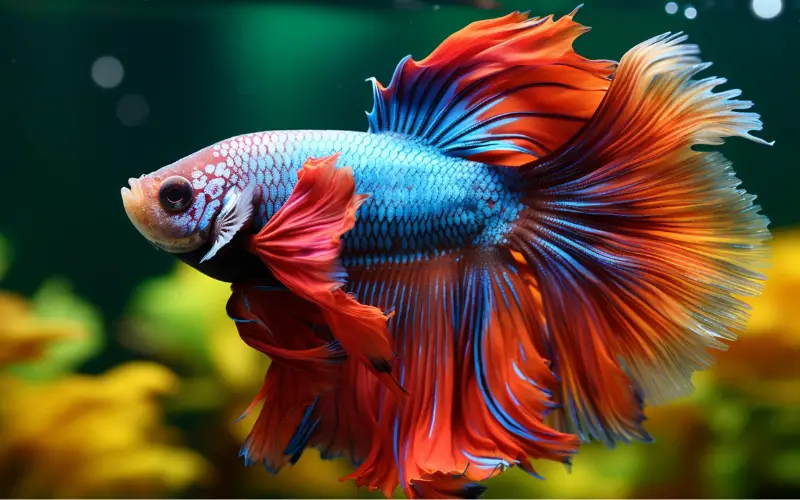
Additionally, online fish retailers can offer a wider variety and selection of live fish, as they can ship them directly to your home.
When looking to buy a Betta Half Moon fish, it’s essential to ensure that they are being sold by reputable sellers who properly care for the fish and provide a healthy environment for them.
It’s also a good idea to research and understand the specific care requirements of Halfmoon Bettas before making a purchase.
Overall, whether you prefer to shop in person at a store or online, there are various options for finding and purchasing a Halfmoon Betta.
Is Halfmoon Betta fish expensive?
Halfmoon Betta fish can be more expensive than the more common Betta varieties, but their price varies greatly depending on several factors:
Fin quality and Coloration:
- Fin shape: High-quality Halfmoons with perfectly symmetrical, flowing fins will be pricier than those with less impressive finnage.
- Color: Rare or unusual colors like koi, metallic, or double-colored varieties can significantly increase the price.
Other factors:
- Age: Younger fish are generally cheaper than older, mature males.
- Bloodline: Fish from renowned breeders known for producing high-quality Bettas will have a higher price tag.
- Source: Local pet stores might sell Halfmoons for moderate prices, while online breeders specializing in high-grade Bettas can charge significantly more.
Price range:
- Moderate: You can find Halfmoon Bettas with decent fin quality and common colors for as low as $15-$25 at pet stores.
- High-end: Bettas with exceptional finnage, rare colors, or from top breeders can fetch $50-$200 or even more.
Here’s a quick breakdown:
| Fin Quality & Coloration | Price Range |
|---|---|
| Common colors, decent finnage | $15-$25 |
| High-quality fins, rare colors | $50-$150 |
| Top-tier bloodline, exceptional finnage | $150-$200+ |
Remember, price isn’t everything! Prioritize finding a healthy fish from a reputable source, regardless of cost.
Aquarium Sizes and Necessary Inclusions for Half Moon Bettas
When setting up an aquarium for Half Moon bettas, it’s essential to consider the size and necessary inclusions for their well-being. Half moon bettas require a minimum tank size of at least 5 gallons, but a larger tank is preferable to ensure they have enough space to swim and explore.
In terms of necessary inclusions, a heater is crucial to maintain a consistent water temperature between 78-82°F, as bettas are tropical fish and require warm water to thrive.
Additionally, a filter is essential to keep the water clean and free of toxins. Live or silk plants and hiding spots should also be included to provide the bettas with a sense of security and places to rest. Lastly, a tight-fitting lid is necessary to prevent bettas from jumping out of the tank.
By providing the appropriate aquarium size and necessary inclusions, half moon bettas can live a happy and healthy life in a well-maintained environment.
Ideal Aquarium Conditions for betta fish halfmoon
Halfmoon bettas, named for their flowing fins that resemble a Half moon, are stunning and relatively easy-to-care-for fish. However, to keep them thriving and displaying their vibrant colors, providing the right aquarium conditions is crucial. Here’s what you need to know:
Tank Size:
- While some sources recommend a minimum of 2.5 gallons, most experts agree that 5 gallons is the absolute minimum for a betta Half Moon fish. Ideally, aim for 10 gallons or more. A larger tank provides more swimming space, helps stabilize water parameters, and reduces stress on your fish.
Water Temperature:
- Bettas are tropical fish, so they need warm water. Maintain a consistent temperature between 78°F and 82°F (25°C and 28°C). Use a reliable aquarium heater and thermometer to monitor the temperature.
Water Quality:
- Good water quality is essential for your Betta’s health.
- Filtration: Use a filter suitable for the tank size and adjust the flow to be gentle, as bettas dislike strong currents. Sponge filters are popular choices.
- Water Changes: Perform weekly 25-50% water changes using a siphon to remove debris and waste.
- pH: Aim for a pH level between 6.5 and 8.0. Use aquarium testing kits and water conditioners to adjust the pH if necessary.
- Ammonia and Nitrite: Keep ammonia and nitrite levels at 0 ppm. These are toxic to fish and can cause serious health problems.
Décor and Enrichment:
- Provide your Betta with hiding places and enrichment like live or silk plants, driftwood, rocks, and caves. These elements help reduce stress and mimic their natural habitat.
- Avoid sharp decorations that could tear your Betta’s delicate fins.
Tank Mates:
- Halfmoon bettas can be territorial, especially towards other male bettas. Therefore, keeping them alone is generally recommended. However, some tank mates can work, such as peaceful shrimp, snails, or small docile fish. Always research carefully before introducing tank mates.
Live Plants:
- Live plants are not only aesthetically pleasing but also beneficial for your Betta’s health. They help oxygenate the water, absorb nitrates, and provide hiding places. Choose low-maintenance plants like Java fern, Anubias, and Amazon sword.
Feeding:
- Feed your Betta a high-quality diet of pellets or flakes specifically formulated for bettas. Supplement their diet with occasional brine shrimp, bloodworms, or daphnia. Avoid overfeeding, which can lead to health problems.
Lighting:
- Bettas don’t require special lighting, but providing a moderate light cycle (12 hours on, 12 hours off) helps regulate their sleep-wake cycle.
Additional Tips:
- Acclimate your Betta slowly to new water conditions.
- Avoid placing the tank in direct sunlight or drafts.
- Monitor your Betta’s behavior and appearance for any signs of stress or illness.
By following these guidelines, you can create a thriving underwater haven for your beautiful half-moon Betta to enjoy. Remember, happy fish make healthy and vibrant companions!
Acclimating Your Half moon Betta Fish to a New Tank
When acclimating your Half Moon betta fish to a new tank, it’s essential to do so gradually to minimize stress and ensure a smooth transition.
Start by floating the betta fish in a bag or container on the surface of the new tank water for about 15-20 minutes. This will allow the water temperatures to equalize and help the fish adjust to the new environment.
After this, gradually add small amounts of the new tank water to the container every 10-15 minutes over an hour.
Once the fish has had time to acclimate to the water chemistry and temperature, gently release it into the new tank. It’s essential to closely monitor the betta fish during this process, looking for signs of stress, such as rapid breathing or lethargy.
Providing a quiet and dimly lit environment for the first few days in the new tank can also help ease the transition. With patience and care, your Half Moon betta fish should adapt to its new surroundings and thrive in its new home.
Can Betta Fish Half Moon Live With Other Fish in a Community Tank?
While keeping a betta fish alongside other fish in a community tank can be visually stunning and bring more life to your aquarium, it can be challenging, especially for halfmoon bettas. Their flowing fins and generally more territorial nature compared to other betta types require careful consideration and specific tank conditions.
Here’s what you need to know about keeping halfmoon bettas with other fish:
Tank size:
- Minimum 10 gallons: This provides enough swimming space for both the Betta and potential tank mates, reducing stress and territorial behavior.
- Larger is better: Aim for 20 gallons or more if you plan on having a diverse community.
Tank mates:
- Choose peaceful fish: Opt for smaller, non-aggressive species that occupy different areas of the tank, like the bottom or mid-water. Some good options include Corydoras catfish.
- Neon tetras
- Harlequin rasboras
- Shrimp (ghost shrimp, cherry shrimp)
- Snails (mystery snails, nerite snails)
- Avoid Large, aggressive fish like cichlids.
- Fish with long fins that the Betta might mistake for rivals, like guppies.
- Bottom-dwelling fish that might compete with the Betta for food and space.
Décor:
- Provide hiding spots: Plenty of plants, rocks, and driftwood create territories and offer the Betta and other fish a sense of security.
Introducing tank mates:
- Do it slowly: Quarantine new fish before adding them to the main tank to prevent the spread of diseases.
- Monitor closely: Keep an eye on the Betta’s behavior. Signs of aggression include fin nipping, chasing, and flaring of the gills.
- Have an escape plan: Be prepared to remove the Betta or other fish if things don’t work out.
Ultimately, whether or not to keep a halfmoon betta with other fish is a personal decision. Weigh the risks and rewards carefully, prioritize your Betta’s well-being, and be prepared to adapt your setup as needed. With careful planning and suitable tank mates, you can create a thriving and harmonious community tank for your beautiful Halfmoon Betta.
How to Take Care of a Male Halfmoon Betta Fish?
Caring for a male Halfmoon Betta fish involves providing a suitable environment, a proper diet, and attentive maintenance. Start by setting up a tank of at least 5 gallons to give the fish enough space to swim and display its beautiful fins. The tank should be equipped with a heater to maintain a consistent temperature between 75°F and 82°F, as bettas thrive in warm water. A gentle filter is also essential to keep the water clean while avoiding strong currents that can stress the fish.
The tank should be decorated with live or silk plants and hiding spots to mimic their natural habitat and give the betta a sense of security. Use a substrate like smooth gravel or sand to avoid damaging the delicate fins. Water quality is crucial; perform regular water changes of about 25% each week and test the water parameters to ensure proper pH levels (around 6.5–7.5).
Feed the betta a varied diet of high-quality pellets or flakes designed for bettas, supplemented with live or frozen treats like brine shrimp and bloodworms to provide essential nutrients. Feed only what the fish can eat in a few minutes to avoid overfeeding.
Male Halfmoon Bettas are territorial and should not be housed with other male bettas or fin-nipping species. However, they can share a tank with peaceful, compatible fish like snails or small shrimp if the tank is spacious enough. Monitor their behavior and health regularly to ensure they remain active, bright, and free from signs of illness. With proper care, a male Halfmoon Betta can live a vibrant and healthy life for 2–4 years.
Commonly Asked Questions about Double Tail Halfmoon Siamese Fighting Fish (FAQs)
Is the Halfmoon Betta Fighter Fish more aggressive than other types of betta fish?
While there’s no scientific evidence proving specific betta fin types are inherently more aggressive, Halfmoon Bettas are known for their larger, flowing fins, which they’ll readily flare and display to intimidate rivals. This behavior, not fin shape, is a crucial indicator of betta aggression.
How can I tell if my Halfmoon Betta is healthy and happy?
Watch your twintail Halfmoon! A happy betta: Swims actively with flowing fins, not clamped. Has vibrant colors and smooth scales. Eats well and explores near the water’s surface.
Do Halfmoon Betta fish sleep?
Absolutely! Just like us, Halfmoon Bettas need their beauty rest. While they don’t close their eyes, they enter periods of low activity and reduced brain function, often resting on the bottom or leaves.
How do you breed halfmoon betta fish using halfmoon male betta fish and halfmoon female betta fish?
Breeding Bettas requires careful preparation! Choose healthy, vibrant Halfmoon pairs. Set up a breeding tank, let the male build a bubble nest, then gently introduce the female. Watch for mating “hugs” and egg collection by the male. After spawning, remove the female for her safety and focus on raising the fry in separate tanks.
What are the distinguishing features of the Rosetail Betta, and how should they be cared for?
Rosetail Bettas are known for their elaborate, feathery tails with excessive branching. Care involves a warm, filtered tank (5+ gallons), stable water conditions, and avoiding sharp decorations to prevent tail damage.
What makes the “blue halfmoon betta fish” distinct, and how should it be cared for?
The Blue Halfmoon Betta is distinct for its vibrant blue color and a tail that forms a 180-degree spread, resembling a Half moon. Care involves a warm, filtered tank (5+ gallons), stable water conditions, and a balanced diet.
What type of Betta is a butterfly?
The term “Butterfly Betta” doesn’t refer to a specific breed but instead describes a striking color pattern and fin type found in various betta species, most commonly the popular Halfmoon Betta.
How big do Halfmoon male bettas get?
Male Halfmoon Bettas typically reach a full size of 2.5 inches, with their flowing fins often adding to their impressive appearance. This length includes the body and the tail fin, which contributes about Half of the total size.
What is a feather tail betta?
A “feather tail betta” isn’t a distinct breed but a nickname for bettas with excessively branched fins, particularly the tail, creating a feathery appearance. Often considered an extreme type of Rosetail betta, these beauties require spacious tanks and gentle care due to their delicate fins.
Why are halfmoon Betta so expensive?
Halfmoon Betta fish are expensive due to their unique and intricate finnage, vibrant colors, and the breeding efforts involved in achieving the distinct half-moon tail. You can find halfmoon betta fish for sale online or at specialty stores like Petsmart to find the perfect Betta.
How to Remedy Ich or Ick in Betta Fish (White Spots)?
To remedy Ich (white spots) in Betta fish, raise the tank temperature to 78-80°F, add aquarium salt, and use a commercial Ich treatment. Quarantine the infected Betta to prevent the spread. Monitor and maintain water quality throughout the treatment.
What is a Dumbo Halfmoon Betta?
A Dumbo Halfmoon Betta is a unique breed with enlarged pectoral fins resembling Dumbo, the elephant’s ears. These Bettas combine the distinct Dumbo feature with the characteristic half-moon tail, creating a visually striking and sought-after fish in the aquarium hobby.
Do Betta Half Moon fish need frozen food?
Frozen food for Halfmoon Bettas? Yes, but as occasional treats! While high-quality pellets or flakes should be their dietary staple, frozen brine shrimp, bloodworms, or daphnia offer valuable protein and enrichment. Limit treats to 2-3 times a week, in small portions, to avoid digestive issues and maintain a balanced diet.
Final Thoughts
In conclusion, the betta fish halfmoon is a stunning and popular aquarium fish that requires specific care to thrive. With its beautiful, flowing fins and bright colors, it is a joy to watch and care for. However, their unique fin structure does make them more prone to fin damage and infections, so it is essential to provide them with a spacious tank and clean water. Additionally, their aggressive nature means that they should be kept in a tank by themselves to avoid any territorial disputes with other fish. Half-moon bettas are relatively low-maintenance fish, but their care should not be taken lightly.
With the proper attention to their environment, diet, and overall health, Betta Half Moon fish can live long and healthy lives, bringing beauty and tranquility to any aquarium. Overall, if you are willing to devote the time and effort to their care, the Halfmoon Betta fish is a rewarding and delightful addition to any fish enthusiast’s collection.
You might also like
- Purple Betta Fish: Price, Breeding & Names (Exclusive Guide)
- Alien Betta Fish: 7 Essential Care Tips (For Beginners)
- How Much Are Betta Fish Cost? (Ultimate Buyer’s Guide)
- Betta Fish Habitat in the Wild: (Facts & Shocking Truths)
- Are Betta Fish Smart: 10 Fascinating Facts About Bettas!
- Can a Snail Live with a Betta: A Comprehensive Beginner Guide


